Raising Water Consciousness through
World’s Biggest Photo Exhibition and
Largest collection of Photo Stories on Water
Photo Stories | Water and Livelihood
Water Sustainability for Sustainable Agriculture: A Way Forward
Nandita Singh and Om Prakash Singh
15 February, 2018
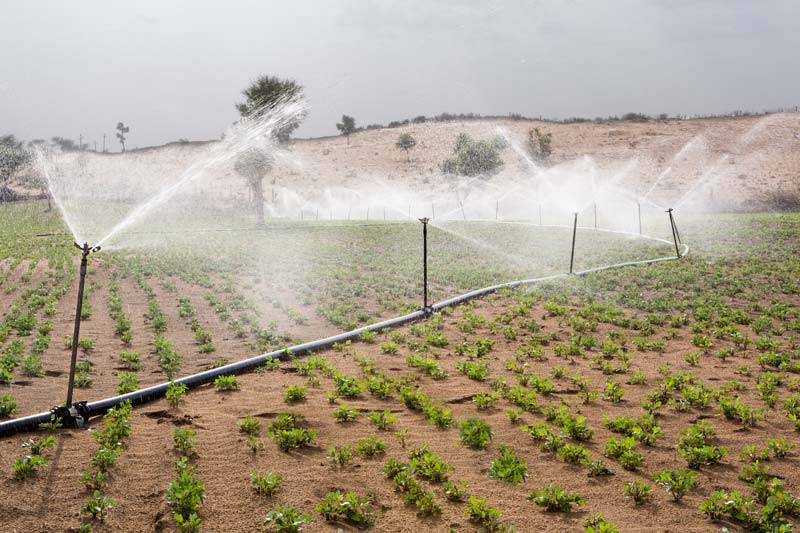
Water is indisputably an essential input in agriculture, whether rainfed or irrigated. The centrality of its role in the Green Revolution in India has been elaborated in the photo story dated 20 December 2017. However, water is also the central resource to be seriously challenged by agriculture, particularly the Green Revolution, as discussed in the photo story dated 15 January 2018. These challenges pertain to both quantity and quality. Expanding networks of irrigation canals siphon off substantial water flows from rivers while over-abstraction of groundwater for irrigation leads to depleting water tables. This causes water shortage for drinking and other basic uses as well as degradation of ecosystems. Use of fertilizers and pesticides for enhancing crop production leads to water pollution that poses human health hazards as well as ecological problems. While Green Revolution focused primarily on foodgrains, the problems highlighted above are not exclusive to thses crops. These impacts hold equally true for pulses, oilseeds, other commercial crops like sugarcane and cotton, as well as vegetables and fruits. While expansion of agriculture is essential for fulfilling the needs for the growing population, and socio-economic development of the country in general, the challenges to water sustainability resulting from agriculture can no longer be overlooked. This story aims to propose a way forward for enhancing water sustainability in such a manner that agriculture itself can be practiced sustainably, so that present food and other consumption needs of society can be met without compromising the ability of future generations to do so. It must strive to achieve healthier environment, economic profitability, and social and economic equity. The way forward must be able to lower the irrigation water use and minimize the quality impact on water resources, much of both of which will depend on nature-based solutions. The title photo depicts one such option – irrigation of groundnut crop using sprinklers in Bikaner district, Rajasthan. Sprinkler irrigation is a technique in which a limited amount of water is evenly applied across the crops or cropped area in a rainfall-like pattern, resulting in greater irrigation efficiency per unit of water used.
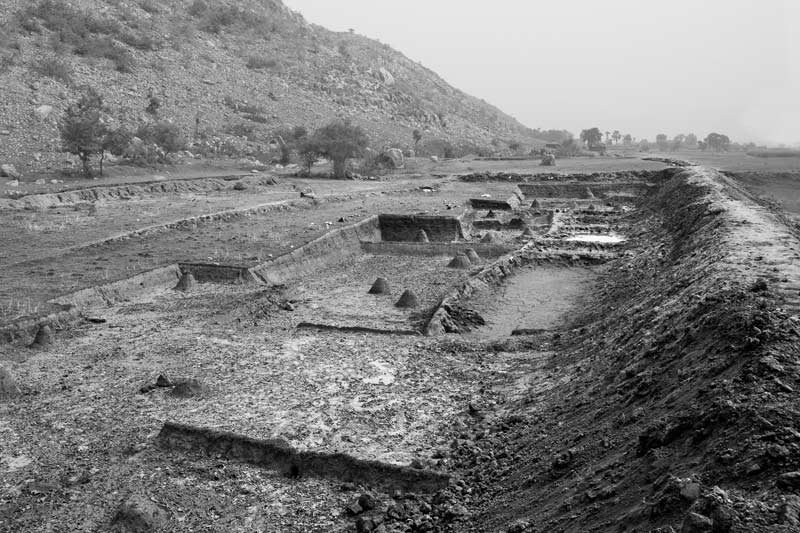
A percolation tank for holding local runoff under construction in Koilu watershed in Munger district, Bihar
The primary source of all water is precipitation which is annually of the order of 4000 billion cubic meters (BCM) in India. 75% of this is received as rainfall during the short monsoon period of June-September. Of this, only 214 BCM can be stored in more than 4,700 large dams and reservoirs in the country, while most of the remaining 95% becomes lost as runoff ultimately flowing down into the ocean & sea. While construction of more large dams to enhance storage can have serious environmental and social consequences, this lost water resource can be tapped more sustainably through development of smaller watershed management structures at the local scale. Examples of such structures include anicuts, checkdams and percolation tanks. Besides providing water for use on the surface, these enable building up of water storage in the soil and underground aquifers. The photo above depicts the construction of a percolation tank in an area where low rainfall, rugged topography and destruction of the green cover had rendered neighboring agricultural fields barren.
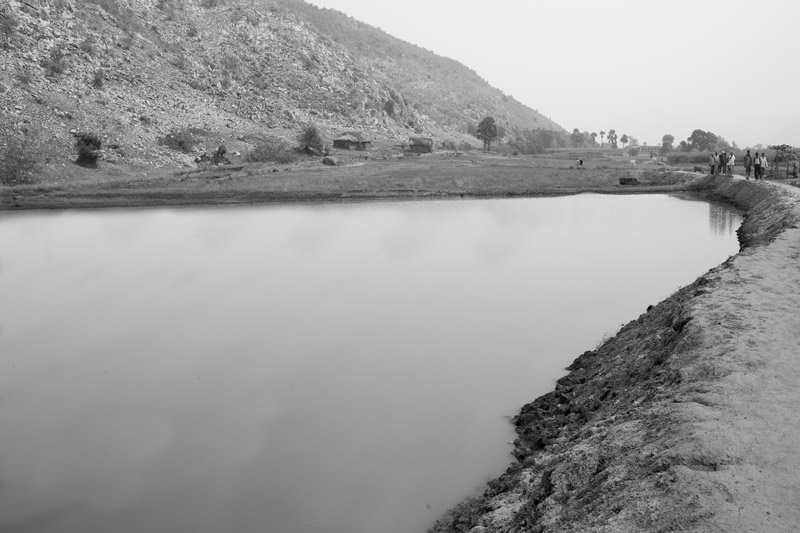
A percolation tank filled by local runoff during monsoon season in Koilu watershed in Munger district, Bihar
Watershed management structures help slow down the speed of the runoff and enable its short-term storage on the surface. This in turn enables its infiltration into the ground, enhancing ‘green water’ storage in the soil and thereby the soil moisture. Increased soil moisture reduces the irrigation need while the green water reserves ultimately reappear as ‘blue water’ in the aquifers from where groundwater may again be withdrawn for irrigation and other uses. Surface water collected through such structures can also be withdrawn and used directly. In the above photo, the percolation tank previously shown under-construction is seen as filled by local runoff during the subsequent rainy season.
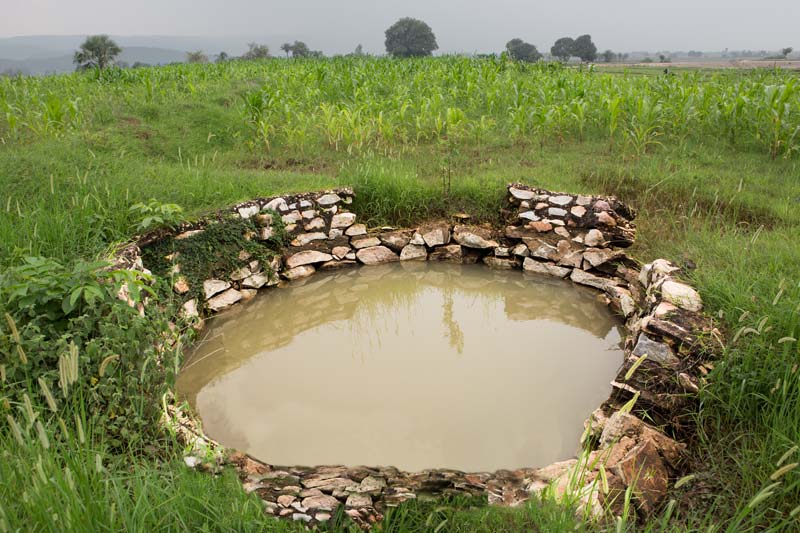
An irrigation well recharged as a result of watershed management efforts in Koilu watershed in Munger district, Bihar
Percolation tanks and other watershed management structures enhance local water availability both on the surface and underground. These can recharge irrigation wells as shown in the above photo and on the whole improve the balance between groundwater withdrawal and recharge, thereby contributing to water sustainability. In Munger district of Bihar from where photos have been depicted above, the average annual rainfall is only 700-800 mm. However, as a result of watershed management structures in six contiguous catchments, more than 5,000 hectares of barren land has been restored as green belt, leading over 9,000 peasant families from poverty to prosperity.
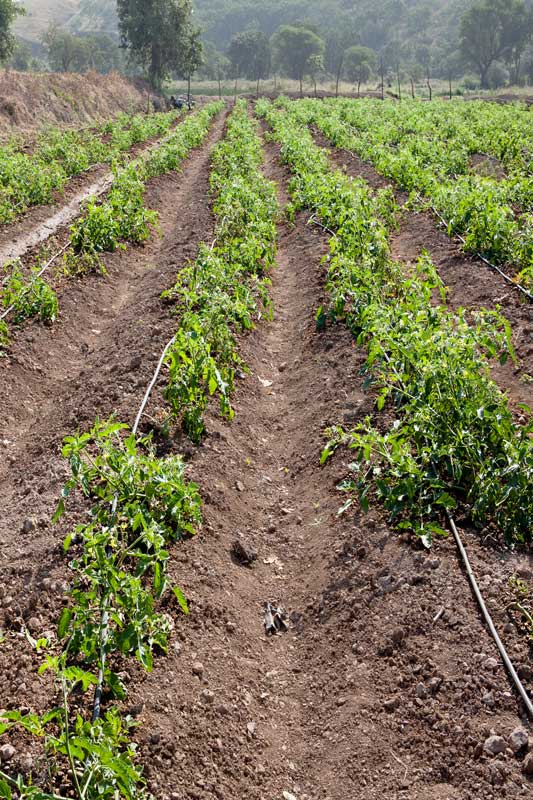
Raising tomato crop through drip irrigation in Ahmednagar district, Maharashtra
Around 60% of water applied as surface irrigation becomes lost through percolation, evaporation or as runoff. Micro-irrigation techniques that involve frequent application of small quantities of water directly above and below the soil surface is a useful alternative for saving such losses. Drip irrigation is a kind of micro-irrigation which reduces water consumption in three ways: first, by using less water which is allowed to drop slowly into the roots of plants at very low rates (1-20 liters/hour); second, by reducing the water demand as application of water continuously into the root zone keeps the soil moist; and third, by minimizing unnecessary water loss through evaporation from unplanted areas. Drip irrigation is already being adopted widely for fruits, vegetables, maize and even commercial crops like sugarcane and cotton. In Maharashtra, where sugarcane cultivation consumes 71% of the irrigation water, drip irrigation has been recently made mandatory in the water-scarce Marathwada region. Regarding major foodgrains, its adoption is however slow. Recent research at Punjab Agricultural University shows its potential for wheat cultivation where water consumption can get reduced by half. Further, in villages near Kota in Rajasthan, farmers have started growing paddy with drip irrigation, reducing water consumption by 40% and increasing yield by 25%.
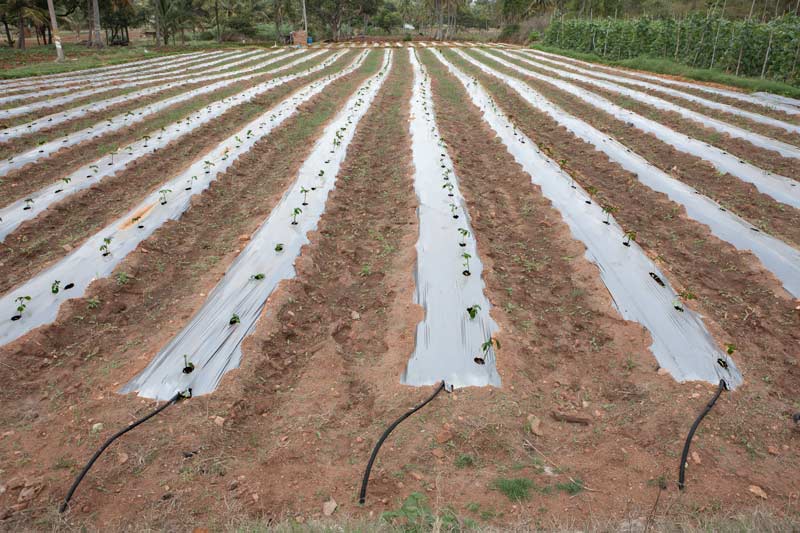
Capsicum crop being grown using plastic mulching combined with drip irrigation in Mandya district, Karnataka
‘Plastic mulching’ is a water-saving technique where a plastic film is applied to the soil surface along crop rows, with crops growing through slits or holes in the film. Plastic mulching offers several benefits, the most significant being reduction in water demand since the plastic mulch does not allow the soil moisture to evaporate. When used together with drip irrigation as shown above, it greatly economizes the use of water for irrigation. It further greatly reduces weed growth resulting in lower herbicide use and also nutrient leaching since applied water is better managed, both of which in turn reduce the risk of groundwater contamination. Though increasingly adopted in vegetable and fruit production in India, the potential of its use in producing cereals is also good, especially in semi-arid and water-stressed areas. Research in China has shown that plastic mulching can significantly increase maize and wheat yields per unit water by upto 60%, while in India increase in yield by 94.5% has been reported for groundnut. In Karnataka which is heavily dependent on groundwater for irrigation, micro-irrigation along with plastic mulching is being promoted by the government, particularly after persistent droughts and crop failures in recent years.
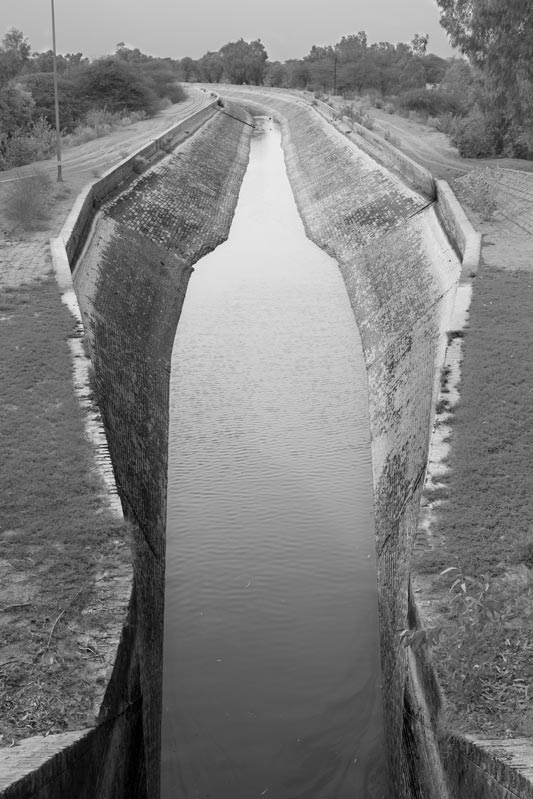
A brick-lined Distributary Branch Canal of the Indira Gandhi Canal system in Bikaner district, Rajasthan
Earthen irrigation channels in permeable soils can cause huge water losses through seepage from the bed and side walls. This leads to less or no water particularly at the tail-end, causing farmers to exploit groundwater instead. A study by the Central Water and Power Commission in 1967 had shown that in a completely unlined canal irrigation system water loss can be as high as 71%, but by lining the system with brick or concrete, this figure can be considerably reduced. Lining programmes have been adopted in some canal irrigation systems, but in most cases these remain confined to the main, distributaries, and minors, while the tail-end watercourse from where losses are known to be the largest often remain neglected. There is need to adopt lining of all irrigation channels, so that the precious water carried by them for irrigation from the source to the tail-end can be efficiently delivered. This in turn will help enhance irrigation using surface water and reduce the dependence on groundwater.
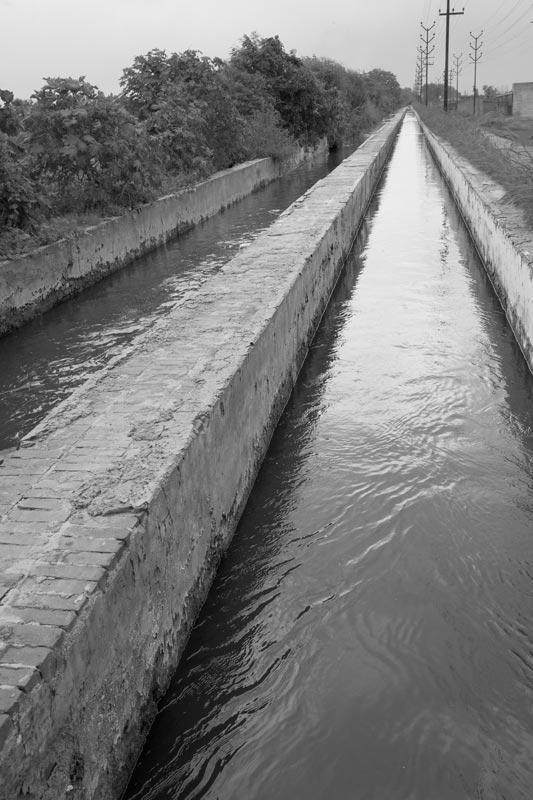
Recycled wastewater being supplied through Shekhpur Canal for irrigation in villages near Jajmau industrial area, Kanpur, Uttar Pradesh
With over 80% of India's water resources diverted for irrigation, and a context of ever-increasing demand due to stressors like climate change and rapid urbanization, there is urgent need to maximize the use of available water resources for irrigation. In this light, wastewater-based irrigation presents a wise option, which enables saving of precious freshwater while also ensuring reliability of supply even during dry season, besides provision of nutrients along with water. All these benefits enable farmers to get higher income at lower costs. In India about 73,000 hectares (ha) peri-urban agriculture is already under wastewater irrigation, with farmers growing cereals, vegetables, flowers and fodder crops. Around Kanpur city, 2,500 ha and 2,447 farming households depend upon wastewater for irrigation supplied by the government for a fee. Shekhpur Canal as depicted in the above photo is one example. Wastewater irrigation however poses health risks for farmers and consumers. There is thus need to ensure proper wastewater treatment for adequate removal of heavy metals and other microbial and chemical contaminants so that ecological, economic and social benefits can be maximized.
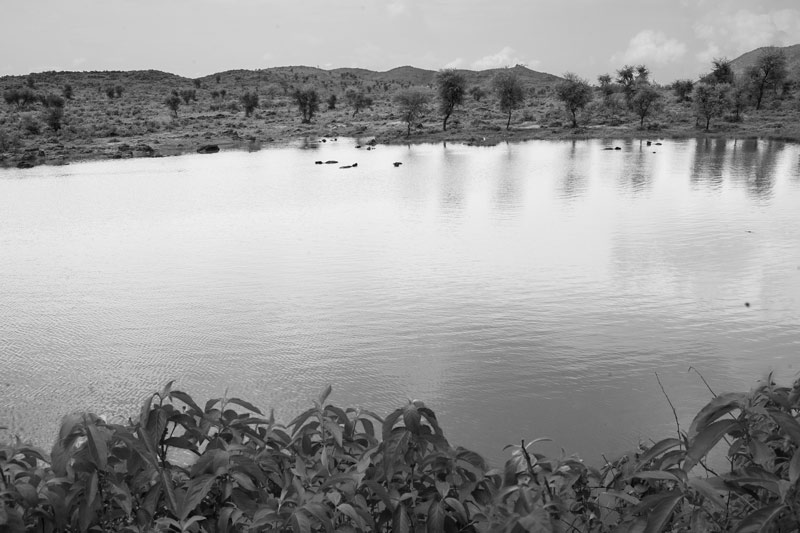
A rejuvenated rainwater harvesting structure called ‘johad’ in Alwar district, Rajasthan
As noted before, India receives a substantial amount of rainfall annually but the capacity to store this water is extremely limited. Following the principle of ‘catch the rain where it falls’, traditional wisdom in India enabled water storage at the local scale through community-based rainwater harvesting (RWH) structures which directly provided surface water and also helped recharge groundwater. RWH structures of different kinds, shapes and sizes have been traditionally widespread across the country, fulfilling irrigation, drinking water and other human and animal needs. The johad in Rajasthan, as shown in the above photo, is commonly constructed at the foothills or on a slope, consisting of a crescent-shaped bund made of earth and/or rocks on three sides towards the lower end while the fourth side on the higher end is left open to allow the runoff to flow in. It acts as a percolation tank recharging the aquifer below, from where water for irrigation is drawn through wells. The surface water stored in the johad is also used for livestock and other purposes. The traditional RWH structures provide a nature-based solution for sustainable agriculture, but unfortunately these are subject to widespread neglect from community as well as authorities today. There is an urgent need to rejuvenate the existing structures, and promote their construction and maintenance in order to enhance irrigation water availability.
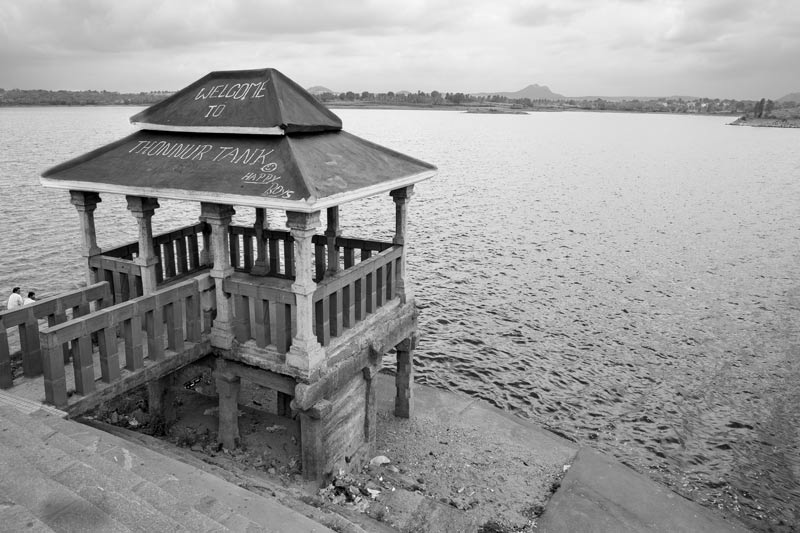
Thonnur Kere - a rejuvenated irrigation tank from 12th century in Mandya district, Karnataka
Tanks have been important source of irrigation in India since time immemorial. According to government sources, about 2.2 million ha of land was irrigated by tanks in 2010-2011, being an important source in Andhra Pradesh, Tamil Nadu, Karnataka, these states together accounting for over one-third of country’s tank-irrigated land. It is also an important irrigation source in eastern Madhya Pradesh, eastern Maharashtra, interior Orissa and Kerala. Thonnur Kere (also called Thondanur or Tirumala Sagara) shown in the above photo, is a large irrigation tank that has supported agriculture for over eight centuries in Karnataka. Unfortunately, after proliferation of irrigation tubewells, many irrigation tanks have come to be neglected. A number of these have become defunct due to encroachment, siltation, choking of supply channels and pollution from industries. In Mandya district in Karnataka, over 14,000 ha of land was under tank irrigation in 1964-65, but this area has been declining. In recent times, a number of irrigation tanks, including the Thonnur Kere along with its canal network which irrigates 287 ha, has been renovated by the government, promoting production of paddy, jowar, ragi, maize and other crops. There is need to actively take up rejuvenation and promotion of use of irrigation tanks in the country so as to augment irrigation water sources for the farmers.
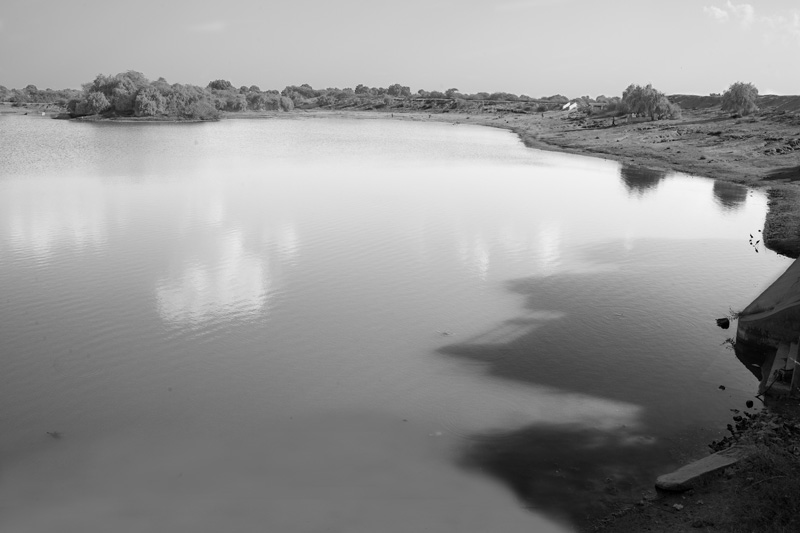
An irrigation pond based on rainwater harvesting in Kutch district, Gujarat
Irrigation is the most essential input for agriculture but if the available water resource is saline, productivity may be severely hampered. In Kutch which is a semi-arid coastal district in Gujarat, salinity of geological formations and increasing salinity ingress due to overexploitation of groundwater is a significant problem which renders upto 60% of the groundwater saline. Use of the saline groundwater through tubewells, wherever adopted, has led to declining agricultural productivity. In this light, the traditional wisdom of growing either rainfed crops or using irrigation tanks based on rainwater harvesting, as shown in the above photo, is an appropriate solution. There is need to protect, rejuvenate and promote the development and management of rainwater harvesting-based irrigation ponds in this district as well as other similarly affected areas in the country.
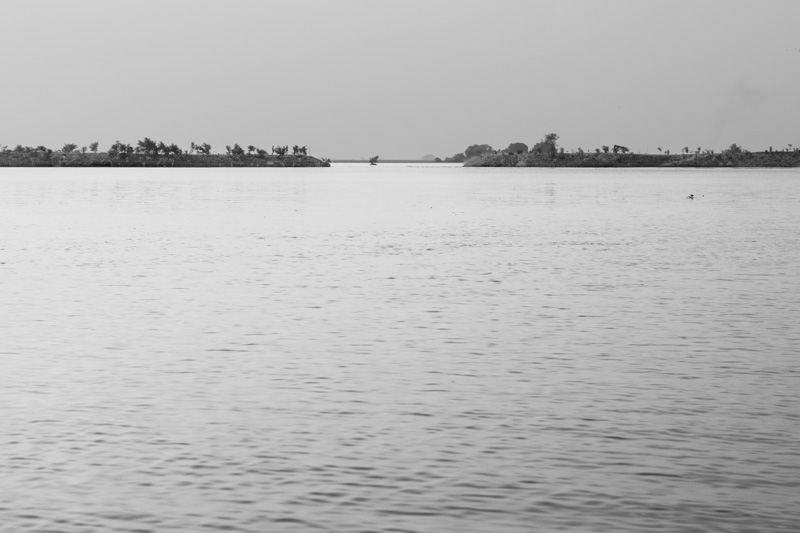
Agricultural fields submerged under floods in Bhojpur district, Bihar
India witnesses annual flooding in several areas due to excessive monsoon rains, with over 40 mha, that is, one-eighth of the total land area of the country, assessed to be flood-prone. Assam, Bihar, Haryana, Punjab, Uttar Pradesh and West Bengal are the worst affected states. Bihar is India's most flood-prone state, with over 73% of its land area flood-affected. The 2013 flood in Bihar affected more than 5.9 million people in 20 out of 38 districts of the state, one of which is depicted in the photo above. Flood is often believed to cause immense suffering and miseries to masses, submerging standing crops and destroying farmers' livelihoods. However, floods also bring many benefits for farmers. It brings new fertile sediments and provides nutrients to the soil that were earlier lacking, thereby enhancing soil fertility. It also enhances soil moisture and enables groundwater recharge. All these benefits ultimately help increase agricultural production in the long run.
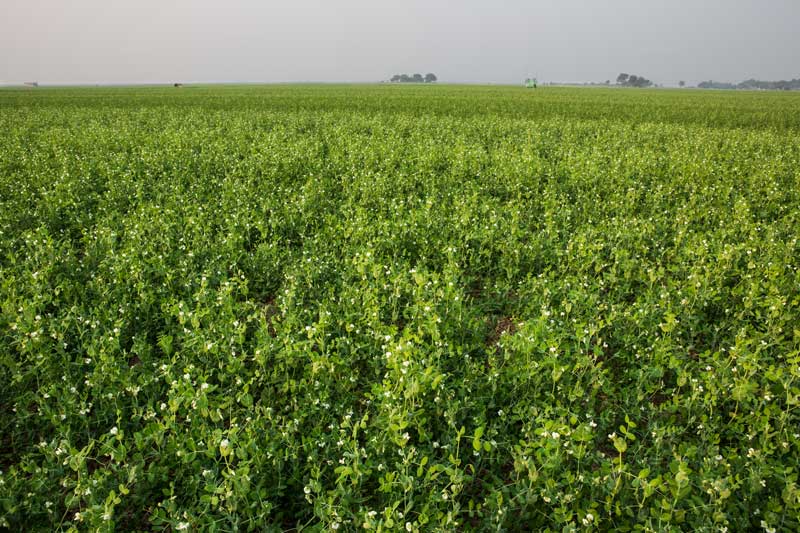
Flood recession farming producing peas, chick peas, wheat and mustard in Bhojpur district, Bihar
Considering the benefits of floods for agriculture, there is a huge potential for adopting flood-based farming systems in areas that experience annual floods in India. In fact, farmers have already been practicing for generations methods to cope with the annually occurring floods and use them to maximize their production. Flood recession agriculture is the most common form of such adaptation where the residual moisture and enhanced fertility of seasonally flooded lands is used for agriculture after the waters recede. Examples include diara-land farming where vegetables such as cucumber, muskmelon, watermelon and pointed gourd are grown on the bank or basin of river after flood levels receded. In the flooded region shown in the earlier photo, though paddy cultivation during kharif (monsoon) season was affected due to inundation, a bumper rabi (winter) crop of peas, chick peas, wheat and mustard was obtained by farmers after recession of the flood water. There is need to realize the economic potential of flood recession farming in the country and promote its adoption in different forms in the flood-prone regions so that can maximum benefit for agricultural production can be drawn from the naturally occurring floodwater resources.
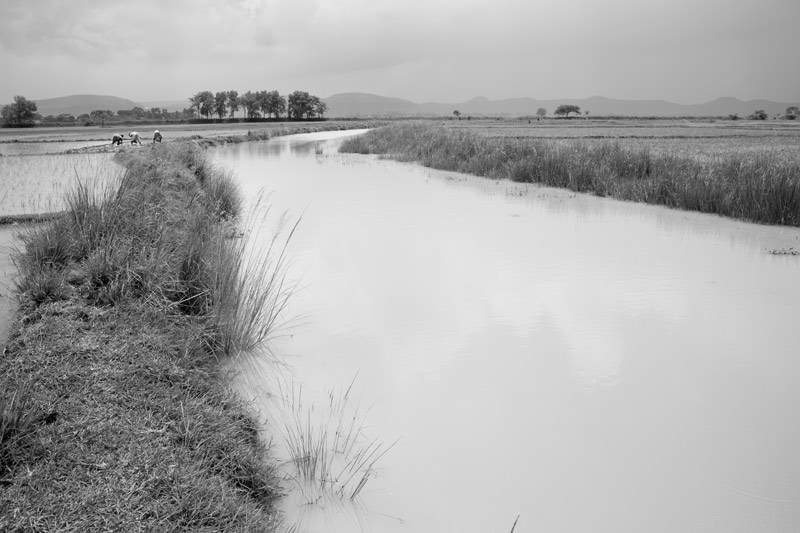
A 'pyne' carrying irrigation water from an 'ahar' through agricultural fields to the next 'ahar' in series in Kaimur district, Bihar
Another flood-based farming system in use for more than 2000 years is the Ahar-Pyne system in the southern Gangetic Plains of Bihar, which has transformed an area with sandy soil and low water table into the 'rice bowl' of Bihar. The system continues to be in use in districts like Kaimur, Rohtas, Aurangabad, Gaya, Jahanabad and Patna. Rivers in this region swell only during the monsoon, and the water carried by them may become lost unless impounded and stored for later use. 'Ahar' is a water reservoir constructed for this purpose with embankments on three sides to impound the runoff flowing into it through the fourth side. On the lower side, sluices are provided to allow the excess water to be released. 'Pyne' is a water channel constructed to serve one of the following functions: to divert the water flowing down seasonal hilly rivers into ahars, or to convey water from ahars into fields, or to convey water from one ahar in a series to the next, or even to disperse flowing stream water into agricultural fields during the monsoons. The Ahar-Pyne system not only enables irrigated paddy and sugarcane cultivation in kharif season, but also wheat, pulses, oilseeds and vegetables during rabi season. It also offers flood-protection during monsoons and helps 'climate-proof' against delayed or scanty rainfall . There is need to promote the development of such nature-based solutions suited to specific agro-climatic conditions so that agriculture can be made more sustainable and available water resources can be most efficiently utilized.
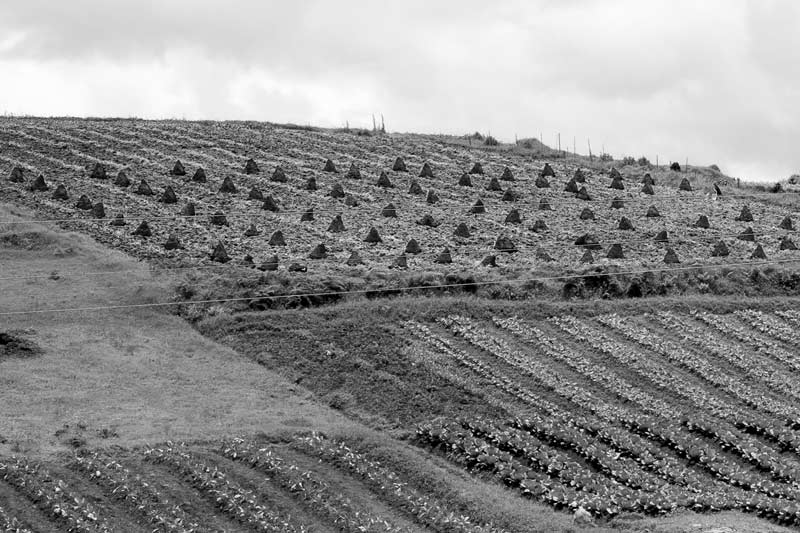
Vegetables grown using organic manure in East Khasi Hills district, Meghalaya
In order to enhance sustainability in agriculture, organic farming has been promoted as an alternate way forward, which may be defined as an integrated farming system that strives for enhancement of soil fertility and biological diversity without using synthetic fertilizers, pesticides, and other agrochemicals. Use of organic manure as shown above is a key component of this system. Research studies demonstrate that compared to conventional farms, organically farmed soils tend to have less nitrogen leaching; better nutrient and water-holding ability; and less polluted runoff, which in turn leads to better on-farm water management. The keys to these advantages lie in high levels of soil organic matter and an active community of soil organisms. Better soil quality also enhances water-holding capacity which in turn can reduce the irrigation need. Therefore, organic cotton farming is known to need less irrigation and thus conserve water. Organic farming system in India is not new and is being followed from ancient times. Given the benefits of organic farming in general and its advantages towards upkeep of water quality and water conservation, there is need to promote and popularize this nature-based practice in the country.
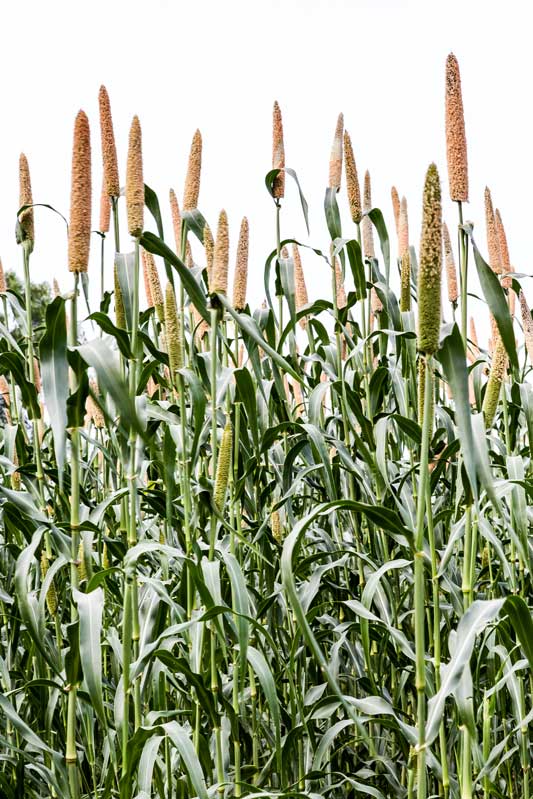
Pearl millet being grown in Morena district, Madhya Pradesh
The traditional mode of agriculture was based on crops that were adapted to the local agro-climatic conditions such as rainfall, temperature, soil type and water availability. For example, in Morena district the soil type is alluvial but the climate is hot and dry, with only about 700 mm annual rainfall. Thus, water availability for agriculture is limited and under these conditions, pearl millet (Bajra) has been traditionally grown as a rainfed kharif crop as shown in the photo above. Production of crops adapted to the local agro-climatic conditions presents a solution for water sustainability by avoiding wasteful use of water and also that of fertilizers and pesticides which otherwise degrade water quality. This contrasts with the basic requirements under modern agriculture or Green Revolution where irrigation and heavy inputs of fertilizers and pesticides drive crop productivity. Considering the benefits of traditional agricultural modes, there is need to revive and promote cropping patterns that are adapted to local agro-climatic conditions, so as to enable water sustainability and thereby sustainable agriculture.
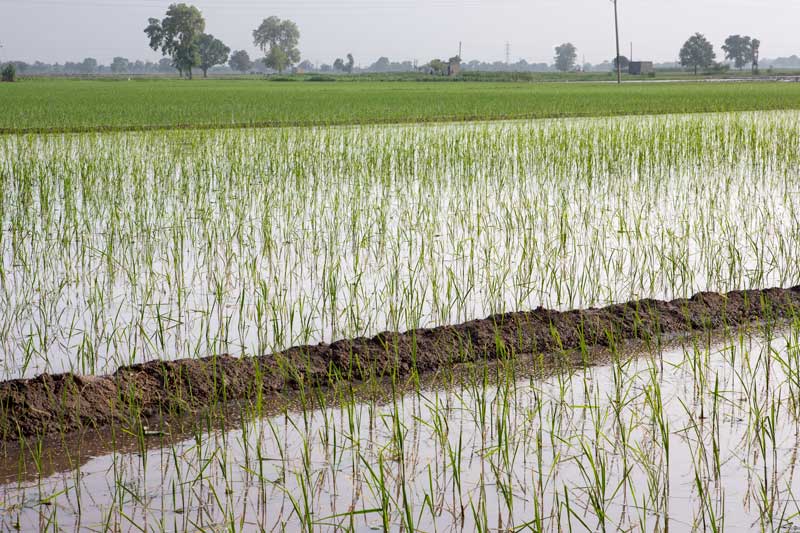
Paddy crop being cultivated in Fatehabad district, Haryana
A number of crops grown in India are water-intensive, requiring irrigation with large quantities of water for maximum productivity. The water requirement per kilo production of the most important crops are: rice requiring 3,000-5,000 liters water, sugarcane requiring 1,500-3,000 liters water, cotton (the irrigated variety with higher productivity) requiring 22,500 liters water, and wheat requiring 900 liters water. Since these crops are essential for fulfilling the growing food and consumption needs of the country, their production cannot be halted, but there is urgent need to develop and use new techniques and varieties that can enable higher production with lesser water inputs. For example, the system of rice intensification (SRI) is a new and evolving alternative to conventional methods of rice cultivation which has the potential to cut water requirement by 50% and simultaneously boost production by 50%. In SRI, rice seedlings are transplanted early in un-puddled condition; the fields are alternately kept wet and dry; and flooding of the field is required only during the reproductive phase. A hybrid variety called KRH-4 has been developed by the University of Agricultural Sciences, Bangalore in support of this technique and it is being practiced by farmers in Mandya, Mysore, Hassan, Tumkur, Shimoga and Ramanagaram districts of Karnataka. There is need to promote SRI and develop similar techniques and varieties for other water-intensive crops.
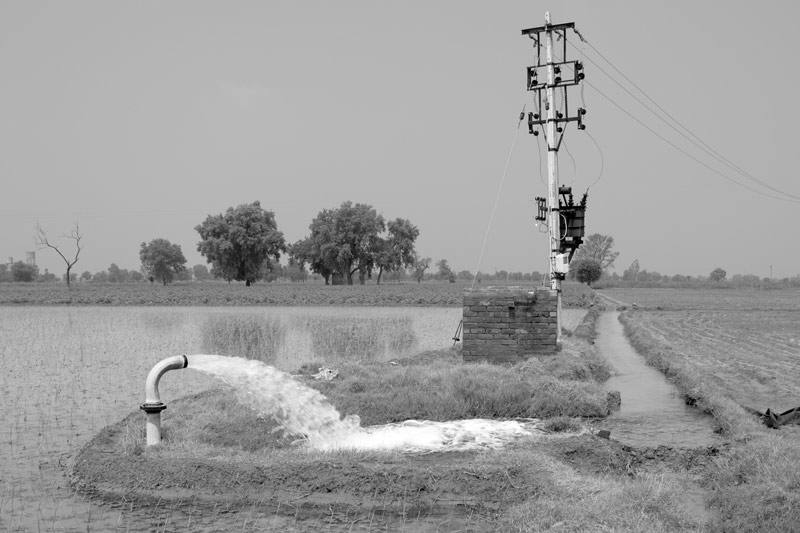
Free electricity being supplied for irrigation in Mansa district, Punjab
Electricity has been a critical factor enabling groundwater-based irrigation in India, in turn achieving higher productivity. However, a policy of highly subsidized or even free electricity to farmers in many states has resulted in wasteful overuse of precious groundwater by them, driven by the greed of higher production and therefore maximization of profit. It has boosted them to grow water-intensive crops in completely unfavorable agro-climatic conditions, such as rice, sugarcane and cotton in semi-arid areas having little rainfall and sandy soils. An important example is the semi-arid south-western Malwa region of Punjab, where groundwater-based cultivation of these crops in districts like Mansa is leading to rapid groundwater depletion. Also, since groundwater for irrigation is available round the year, many farmers take multiple crops of these varieties in a single year, further increasing the pressure on groundwater. For example, in Nellore district of Andhra Pradesh, paddy is grown three times a year using primarily groundwater. Water sustainability and sustainable agriculture requires a reversal of this action. One of the solutions can be discontinuation of highly subsidized or free electricity. Paying appropriately for the electricity used may serve as a disincentive for running motors to withdraw groundwater in unlimited quantities. Simultaneously, there is also need to sensitize farmers about long-term consequences of their action in relation to water and agricultural sustainability. Disincentive as well as sensitization may together equip them to take greater responsibility towards using electricity for groundwater withdrawal more judiciously.
This photo story has attempted to define a way forward towards greater water sustainability in the agricultural sector. In a nutshell, on the quantity front, it proposes a two-pronged approach. First is to minimize the water use for irrigation as well as irrigation water losses through different methods such as drip irrigation, sprinklers, plastic mulching, and lining of irrigation canals; adoption of low water-intensive cropping processes and seed varieties; and introduction of measures so as to reduce water abstraction for irrigation. Second is to maximize the use of available water resources for agriculture in different ways, such as by protecting, rejuvenating and promoting traditional irrigation systems based on rainwater harvesting and flood-based irrigation; promoting development of watershed management structures; adopting cropping patterns that are adapted to the given agro-climatic conditions; and recycle and reuse of wastewater. On the quality front, it proposes promotion of nature-based agricultural inputs rather than chemical fertilizers and pesticides through revival of organic farming practices. It is estimated that India will have 1.7 billion people by 2050, which will require cereal production to grow by at least 4.2% a year, more than twice the current rate. Clearly, if agricultural growth is to be sustainably achieved, this would depend upon considering how much more water can be harnessed for agriculture and how much more efficiently it can be utilized, so that the water availability for other sectors is not hampered and that high levels of production can be maintained over long periods of time in the future.
Producing sufficient foodgrains is essential for fulfilling the basic human right to food of the women, men and children residing in India. Besides, since it is primarily an agricultural country with over 53% population dependent on the sector, increasing the production of cash crops like cotton, sugarcane and oilseeds is also important for gaining sufficient economic returns for farmers and others engaged in the sector, in order to enable their own socio-economic development. However, since water is the core resource that enables this, and climate change impacts on water are already imminent, there is an urgent need to re-organize action in this sector so that the Sustainable Development Goals can be ultimately realized. Towards this end, besides direct actions for promoting sustainability of water resources in quantitative and qualitative terms as summarized earlier, there is also need to bring about greater sensitization among farmers towards the negative consequences of their present actions and the benefits that can accrue from adoption of “eco-climatically friendly” agricultural practices.